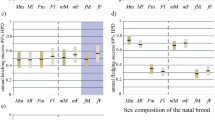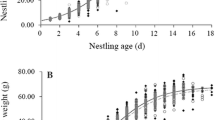Abstract
Biased mortality of the larger sex during the early developmental period has been reported for a number of size-dimorphic bird species. This can partly be explained by the fact that growing to larger size renders the larger sex more vulnerable to food shortage. However, since sibling rivalry is often size-dependent, chicks of the larger sex should have a competitive advantage. This raises the question as to why the larger sex does not always benefit from its size in sibling competition. We studied sibling competition in the black-headed gull (Larus ridibundus), a sexually-size dimorphic species with male-biased mortality. We manipulated the natural brood sex ratio and placed one male chick in direct competition with one female chick while concurrently controlling for differences in age, size and laying order. Male chicks outgrew their female siblings by 15% in asymptotic body mass and did not suffer from enhanced mortality. Female chicks tended to be more alert when the parents returned to the nest and were more persistent in gull-typical begging displays. Females were more likely to get the first food item, but they did not get more food, possibly due to a size-mediated dominance over the non-monopolizable regurgitated food. Thus, it is unlikely that sex differences in competitiveness significantly contribute to male-biased mortality in black-headed gulls. The previously reported male-biased mortality is more likely due to a disadvantage of a higher food demand and a higher sensitivity towards low egg quality, as has been shown in previous studies.


Similar content being viewed by others
References
Anderson DJ, Reeve J, Gomez JEM, Weathers WW, Huston S, Cunningham HV, Bird DM (1993a) Sexual size dimorphism and food requirements of nestling birds. Can J Zool 71:2541–2545
Anderson DJ, Budde C, Apanius V, Gomez JEM, Bird DM, Weathers WW (1993b) Prey size influences female competitive dominance in nestling American Kestrels (Falco sparverius). Ecology 74:367–376
Arroyo B (2002) Sex-biased nestling mortality in the Montagu’s harrier Circus pygargus. J Avian Biol 33:455–460
Badyaev AV (2002) Growing apart: an ontogenetic perspective on the evolution of sexual size dimorphism. Trends Ecol Evol 17:369–378
Blank JL, Nolan V (1983) Offspring sex ratio in red-winged blackbirds is dependent on maternal age. Proc Natl Acad Sci USA 80:6141–6145
Blount D, Surai PF, Nager RG, Houston DC, Møller AP, Trewby ML, Kennedy M (2002) Carotenoids and egg quality in the lesser black-backed gull Larus fuscus: a supplemental feeding study of maternal effects. Proc R Soc Lond B 269:29–36
Bradbury RB, Griffiths R (1999) Sex-biased mortality is influenced by hatching asynchrony in the lesser black-backed gull Larus fuscus. J Avian Biol 30:316–322
Bryk AS, Raudenbush SW (1993) Hierarchical linear models: application and data analysis method. Sage, Newbury Park
Clutton-Brock TH (1991) The evolution of parental care. Princeton University Press, Princeton
Clutton-Brock TH, Albon SD, Guinness FE (1985) Parental investment and sex differences in juvenile mortality in birds and mammals. Nature 313:131–133
DeKogel CH (1997) Long-term effects of brood size manipulation on morphological development and sex-specific mortality of offspring. J Anim Ecol 66:167–178
Dzus EH, Bortolotti, Gerrard JM (1996) Does sex-biased hatching order in bald eagles vary with food resources? Ecoscience 3:252–258
Eising CM, Groothuis TGG (2003) Yolk androgens and begging behavior in black-headed gull chicks: and experimental field study. Anim Behav 66:1027–1034
Eising CM, Eikenaar C, Schwabl H, Groothuis TGG (2001) Maternal androgens in black-headed gull (Larus ridibundus) eggs: consequences for chick development. Proc R Soc Lond B 268:839–846
Fargallo JA, Laaksonen T, Korpimaki E, Poyri V, Griffith SC, Valkama J (2003) Size-mediated dominance and begging behaviour in Eurasian kestrel broods. Evol Ecol Res 5:549–558
Glutz von Blotzheim UN, Bauer KM (1982) Handbuch der Vögel Mitteleuropas. Band 8. Wiesbaden
Griffiths R (1992) Sex-biased mortality in the lesser black-backed gull Larus fuscus during the nestling stage. Ibis 134:237–244
Griffiths R, Double MC, Orr K, Dawson RJG (1998) A DNA test to sex most birds. Mol Ecol 7:1071–1075
Groothuis TGG, Eising CM, Blount JD, Surai P, Apanius V, Dijkstra C, Müller W (2006) Multiple pathways of maternal effects in black-headed gull eggs: constraint and mutual adjustment. J Evol Biol 4:1304–1313
Henderson BA (1975) Role of chick’s begging behavior in the regulation of parental feeding behavior of Larus glaucescens. Condor 77:488–492
Hipkiss T, Hörnfeldt B, Eklund U, Berlin S (2002) Year-dependent sex-biased mortality in supplementary-fed Tengmalm’s owl nestlings. J Anim Ecol 71:693–699
Hunt GL, Hunt MW (1976) Gull chick survival: the significance of growth rates, timing of breeding and territory size. Ecology 57:62–75
Iacovides S, Evans RM (1998) Begging as graded signals of need for food in young ring-billed gulls. Anim Behav 56:79–85
Kitaysky AS, Kitaiskaia EV, Piatt JF, Wingfield JC (2003) Benefits and costs of increased levels of corticosterone in seabird chicks. Horm Behav 43: 140–149
Krijgsveld KL, Dijkstra C, Daan S (1998) Energy requirements for growth in relation to sexual size dimorphism in marsh harrier Circus aerogineus nestlings. Physiol Zool 71:693–702
Lack D (1954) The natural regulation of animal numbers. Clarendon Press, Oxford
Martins TLF (2004) Sex-specific growth rates in zebra finch nestlings: a possible mechanism for sex ratio adjustment. Behav Ecol 15:174–180
Mock DW, Parker GA (1997) The evolution of sibling rivalry. Oxford University Press, Oxford
Mock DW, Drummond H, Stinson CH (1990) Avian siblicide. Am Sci 78:438–449
Müller W, Dijkstra C, Groothuis TGG (2003) Inter-sexual differences in T-cell-mediated immunity of black-headed gull chicks (Larus ridibundus) depend on the hatching order. Behav Ecol Sociobiol 55:80–86
Müller W, Kalmbach E, Eising CM, Groothuis TGG, Dijkstra C (2005a) Experimentally manipulated brood sex ratios: growth and survival in the black-headed gull (Larus ridibundus), a sexually dimorphic species. Behav Ecol Sociobiol 59:313–320
Müller W, Groothuis TGG, Eising CM, Dijkstra C (2005b) An experimental study on the causes of sex-biased mortality in the black-headed gull—the possible role of testosterone. J Anim Ecol 74:735–741
Nager RG, Monaghan P, Griffiths R, Houston DC, Dawson R (1999) Experimental evidence that off spring sex ratio varies with maternal condition. Proc Natl Acad Sci USA 96:570–573
Nager RG, Monaghan P, Houston DC, Genovart M (2000) Parental condition, brood sex ratio and differential young survival: an experimental study in gulls (Larus fuscus). Behav Ecol Sociobiol 48:452–457
O’Connor RJ (1978) Brood reduction in birds: selection for fratricide, infanticide and suicide? Anim Behav 26:79–96
Råberg L, Stjernman M, Nilsson JA (2005) Sex and environmental sensitivity in blue tit nestlings. Oecologia 145:496–503
Rasbash J, Browne W, Healy M, Cameron B, Charlton C (2000) Multilevel models project. University of London, London
Riedstra B, Dijkstra C, Daan S (1998) Daily energy expenditure of male and female marsh harrier nestlings. Auk 115:635–641
Richter W (1983) Balanced sex ratios in dimorphic birds: the contribution of sex-specific growth dynamics. Am Nat 121:158–171
Ricklefs RE (1968) Patterns of growth in birds. Ibis 110:419–451
Rodriguez-Girones MA (1999) Sibling competition stabilises signalling resolution models of parent–offspring conflict. Proc R Soc Lond B 266:2399–2402
Rodriguez-Girones MA, Enquist M, Lachmann M (2001) Role of begging and sibling competition in foraging strategies of nestlings. Anim Behav 61:733–745
Røskraft E, Slagsvold T (1985) Differential mortality of male and female offspring in experimentally manipulated broods of the rook. J Anim Ecol 54:261–266
Royle NJ, Surai PF, McCartney RJ, Speake BK (1999) Parental investment and egg yolk lipid composition in gulls. Funct Ecol 13:298–306
Sayce JR, Hunt GL (1987) Sex ratios of prefledging western gulls. Auk 104:33–37
Smith TE, Leonard ML, Smith BD (2005) Provisioning rules and chick competition in asynchronously hatching common terns (Sterna hirundo). Behav Ecol Sociobiol 58:456–465
Teather KL (1992) An experimental study of competition for food between male and female nestlings of the red-winged blackbird. Behav Ecol Sociobiol 31:81–87
Torres R, Drummond H (1997) Female-biased mortality in daughters of a bird with size dimorphism. J Anim Ecol 66:859–865
Vedder O, Dekker AL, Visser GH, Dijkstra C (2005) Sex-specific energy requirements in nestlings of an extremely sexually size dimorphic bird, the European sparrowhawk (Accipiter nisus). Behav Ecol Sociobiol 58:429–436
von Engelhardt N, Carere C, Dijkstra C, Groothuis TGG (2005) Elevation of yolk testosterone abolishes sex differences in begging and growth of zebra finches. Proc R Soc Lond B 273:65–70
Acknowledgements
We would like to thank Akzo Nobel Delfzijl (particularly Harry Rodenhuis and Frans Riedstra) for giving us the permission to work on their properties. We are much obliged to Jenny de Vries for her contribution to the behavioural observations. The experiment was performed in accordance with the laws and regulations of The Netherlands and approved by the animal experimentation committee of the University of Groningen under license DEC 2698. This project was supported by a PhD studentship from the University’s Center for Behaviour and Neurosciences and a postdoctoral grant from FWO Vlaanderen (Belgium) to WM.
Author information
Authors and Affiliations
Corresponding author
Additional information
Communicated by F. Bairlein.
Rights and permissions
About this article
Cite this article
Müller, W., Groothuis, T.G.G. & Dijkstra, C. Consequences of sex-specific growth on sibling competition in black-headed gulls: a sexually-size dimorphic species with scramble competition. J Ornithol 148, 495–502 (2007). https://doi.org/10.1007/s10336-007-0189-2
Received:
Revised:
Accepted:
Published:
Issue Date:
DOI: https://doi.org/10.1007/s10336-007-0189-2




